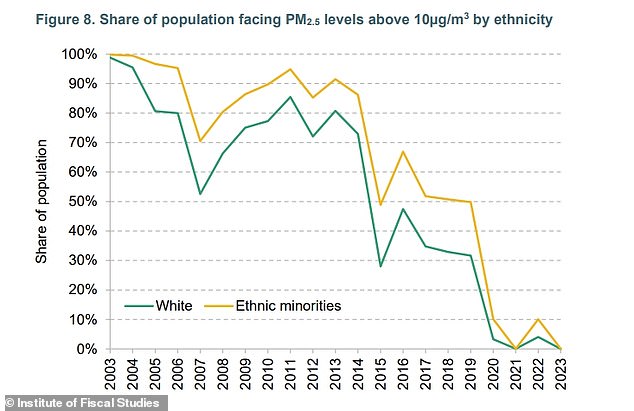Trendy wood burning stoves are the UK’s biggest source of the most dangerous type of air pollution called PM2.5, new research shows.
A drop in particulate pollution from road transport and heavy industry such as steel has meant parts of the UK have now got the cleanest air for decades.
But despite the overall downward trend, the use of wood burning stoves is rising, the report from the Institute of Fiscal Studies (IFS) has warned.
Particulate pollution is widely agreed to be the air pollutant with the biggest impact on human health, increasing the risk of respiratory and heart conditions, and increasing hospital admissions.
Children growing up exposed to particulate pollution are more likely to have reduced lung function and can develop asthma as the tiny particles penetrate the lungs and enter into the bloodstream.
The IFS said in its report: ‘The three largest sources of primary PM2.5 in the UK are domestic burning of wood and other fuels (29 per cent of total PM2.5 emissions in 2022), road transport (17.9 per cent of total PM2.5 emissions in 2022), and industrial processes and product use (16.5 per cent of total PM2.5 emissions in 2022) such as construction and steel manufacturing.
‘The only source of PM2.5 emissions that has increased over the period is domestic combustion. Three-quarters of the domestic combustion emissions of PM2.5 came from woodburning in 2022.’
Only stoves officially given the ‘Ecodesign’ mark are allowed for sale in the UK and any wood for sale must be certified ‘Ready to burn’.

The only source of PM2.5 emissions that has increased since 2003 is domestic combustion, according to the Institute of Fiscal Studies (IFS) report

Trendy wood burning stoves are the UK’s biggest source of the most dangerous type of air pollution called PM2.5, new research shows (stock image)
But in practice, councils carry out minimal regulation of woodburning at home – with just one prosecution by a local authority in England in 2022, despite 10,600 complaints by residents, according to research carried out by pressure group Mums for Lungs.
Overall, the report said that in most parts of the UK, levels of PM2.5 pollution had fallen to below the government’s 2040 target, although not below the more stringent limit set out by the World Health Organisation.
‘The share of the English population exposed to levels of PM2.5 above England’s 2040 target fell from 99 per cent in 2003 to less than 0.1 per cent in 2023,’ it said.
Air pollution fell steeply during the pandemic but has remained at lower levels since.
Between 2003 and 2023, average levels of PM2.5 in England fell by 54 per cent.
A 2022 study cited by Professor Chris Whitty, chief medical officer for England, showed that even ‘Eco-design’ stoves generated 450 times more toxic air pollution than gas central heating, while older stoves now banned from sale produced 3,700 times more.



Bobbie Upton, Research Economist at IFS and an author of the report, said: ‘There is growing evidence that fine particulate air pollution is extremely damaging for health, particularly for children and the elderly.
‘It is hard to fully explain the striking drop in air pollution that started in 2020, during the COVID pandemic.
‘New clean air zones in several of England’s largest cities and reduced steel production may have both played a role.
‘It is important for the nation’s health, and for reducing health inequalities, that progress continues to be made on reducing air pollution.’




The report also found that ethnic minorities were now less exposed to pollution, down to just six per cent more than average levels for white populations in 2023, down from 13 per cent in 2023.
The report said that this fall in the ‘ethnic pollution gap’ was initially down to ethnic minorities moving to less polluted parts of the country (largely moving out of London to a smaller city), while cities with large ethnic minority populations chiefly London and Birmingham have also experienced drops in air pollution.
But the report found that lower-income areas have persistently higher levels of air pollution than richer areas.
In 2023, individuals in the top 20 per cent most deprived areas experienced 8 per cent higher average PM2.5 concentrations than those in the bottom 20 per cent.
* Do you still love your wood burner? Please email: Aidan.Radnedge.MOL@mailonline.co.uk *









